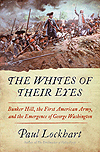
The Whites of Their Eyes: Bunker Hill, the First American Army and the Emergence of George Washington, by Paul Lockhart, Harper, New York, 2011, $27.99
Paul Lockhart begins his entertaining account of the Battle of Bunker Hill by downplaying its military significance. The fighting was bloody but “laughably puny” in scale, and it ended with a British victory that decided nothing. Several months of stalemate followed until the Redcoats departed Boston in March 1776, after George Washington installed his artillery on Dorchester Heights. Even so, the Battle of Bunker Hill remains entrenched in American legend, right up there with Gettysburg and D-Day.
The power of Bunker Hill as an image in national mythology has made it susceptible to misconception and stereotype. Thus the British are remembered as robotic incompetents, marching in dense ranks to their doom. The Americans, by contrast, appear as free-thinking, sharpshooting Patriot farmers, underequipped but full of fight. Lockhart debunks any such myths, replacing them with more balanced portrayals of the battle and its combatants.
The Redcoats who fought at Bunker Hill were somewhat better trained than their American counterparts, but they were raw, inexperienced and prone to crack under the strain of combat. Fortunately for them, Maj. Gen. William Howe and his officers were solid tacticians. The Americans were neither well led nor particularly proficient marksmen—but they had passion, and that made all the difference.
The most refreshing aspect of Lockhart’s account is his focus on the common soldiers and civilians who populated this event. Doing so allows him to present a broad and interesting new perspective on the battle. Big names like Howe, Israel Putnam and Artemas Ward appear regularly, too, and George Washington shows up in the battle’s aftermath. The author’s smooth narrative of the fighting presents Bunker Hill as a public event that crowds of civilians witnessed like an act onstage. This nicely written and carefully researched book offers exciting new insights on the Revolutionary War.
—Edward G. Lengel




